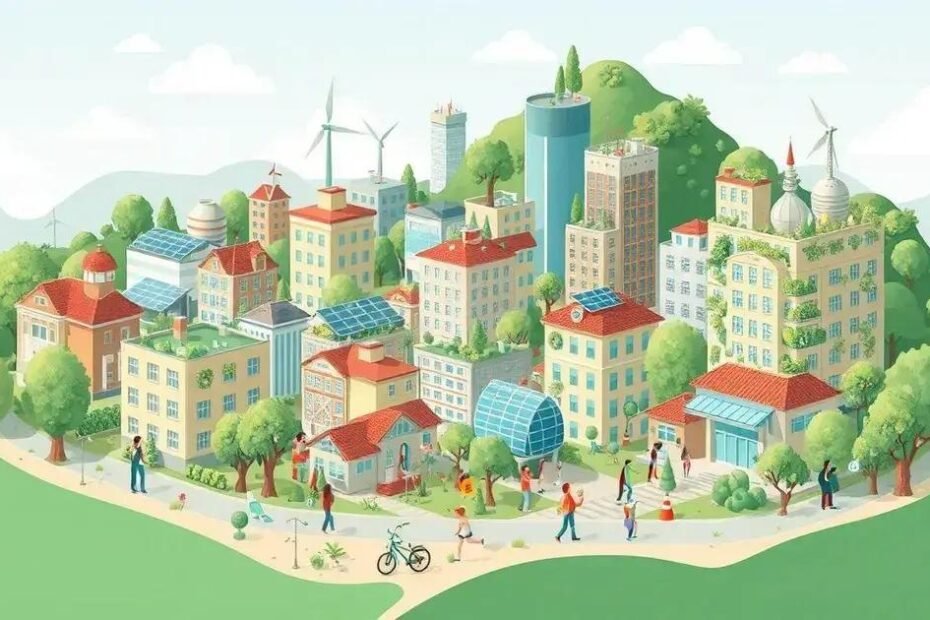Net zero refers to achieving a balance between the greenhouse gases emitted and those removed from the atmosphere, essential for combating climate change and promoting sustainability globally.
Net zero isn’t just a buzzword; it’s a crucial goal for our planet’s future. But what does it really mean for you and your community? In this article, we’ll dive into the concept of net zero, how you can contribute, and why it matters now more than ever.
Understanding net zero and its importance
Understanding net zero is crucial for everyone. It refers to balancing the amount of greenhouse gases emitted with an equivalent amount removed from the atmosphere. But why does this matter? Achieving net zero helps combat climate change and promotes a healthier planet.
Why is net zero important?
First and foremost, it plays a vital role in ensuring the future of our environment. Without action, global temperatures will continue to rise. This can lead to severe weather events and health risks. Also, communities that adopt net zero practices can see improvements in air quality and public health.
- Reduces greenhouse gas emissions.
- Enhances public health by decreasing pollution.
- Encourages renewable energy sources.
- Promotes sustainable economic growth.
Embracing the concept of net zero can also inspire innovation. Businesses and governments are looking for new ways to minimize their carbon footprints. From electric vehicles to efficient energy systems, the opportunities are endless. As a result, we can envision a future that thrives on clean energy and low emissions.
The global impact of net zero
Globally, countries are setting ambitious targets to reach net zero by 2050. This commitment reflects a growing recognition of the urgent need for action. To achieve this, individuals and businesses must cooperate and share best practices. Whether it’s through reducing waste or improving energy efficiency, each step counts towards a sustainable future.
Furthermore, education plays a significant role in this transition. People need to understand the importance of net zero to drive change in their communities. By fostering awareness and leading by example, we can create a more sustainable world.
Key strategies for achieving net zero
Achieving net zero requires clear strategies that focus on reduction and removal of greenhouse gases. It’s essential to take actionable steps that contribute to this goal. Let’s explore some key strategies that can make a significant impact.
Energy efficiency improvements
One primary method is enhancing energy efficiency in buildings and transportation. This helps lower overall energy consumption, which in turn reduces emissions. Simple changes can lead to substantial benefits, like upgrading insulation or switching to LED lighting.
- Conduct energy audits to identify inefficiencies.
- Invest in high-efficiency appliances.
- Encourage public transportation and carpooling.
Moreover, transitioning to renewable energy sources is vital. Using solar, wind, and hydro power significantly cuts down on fossil fuel reliance. Households and businesses can install solar panels to harness clean energy. This not only benefits the environment but also reduces energy bills.
Carbon offsetting and removal
Another strategy involves carbon offsetting and removal. This means investing in projects that capture carbon, such as reforestation or carbon capture technologies. By supporting these initiatives, you can ensure that any emissions produced are balanced out with equivalent reductions elsewhere.
- Plant trees and restore natural habitats.
- Participate in or donate to carbon offset programs.
- Support businesses that focus on sustainability.
Engaging communities in sustainability efforts also plays a crucial role. Community-driven projects foster awareness and motivate individuals to participate in the journey to net zero. Organizing local clean-up events or sustainability workshops can spark interest and inspire action.
Challenges in the journey to net zero

While the goal of achieving net zero is admirable, the journey presents numerous challenges that must be addressed. Understanding these obstacles is essential for effective planning and execution. Many people and organizations face these hurdles while striving to create a more sustainable future.
Financial constraints
One significant challenge is the financial burden associated with transitioning to renewable energy and sustainable practices. Initial investments in new technologies can be daunting. This is especially true for small businesses and households. However, it is crucial to remember that these upfront costs can lead to long-term savings through lower energy bills.
- Developing financing solutions and incentives.
- Accessing government grants or subsidies.
- Collaborating with organizations for shared resources.
Moreover, technical knowledge can be a barrier. Many individuals and companies may lack the necessary skills to implement green technologies effectively. Training and educational programs are vital in addressing this knowledge gap.
Policy and regulatory issues
Another challenge involves navigating complex laws and regulations. Policies can vary significantly between regions, complicating implementation efforts. Businesses often face delays in obtaining permits or approvals for renewable projects. To overcome this, it’s essential for communities to advocate for clearer policies.
- Collaborating with local officials on sustainability initiatives.
- Staying informed about changing regulations.
- Engaging in public awareness campaigns.
Additionally, public perception and understanding can slow progress. Some people may be skeptical about climate change and net zero initiatives. This skepticism can hinder support for policies and practices that promote sustainability. Effective communication and education are key to changing minds and rallying communities.
Innovative technologies supporting net zero
Innovative technologies play a pivotal role in achieving net zero goals. From advanced energy sources to smart systems, these breakthroughs can significantly reduce greenhouse gas emissions. Let’s explore some of the most exciting technologies that are facilitating this important transition.
Renewable energy sources
First, renewable energy technologies are essential. Solar panels and wind turbines harness natural resources to generate clean power. Emerging technologies like floating solar farms and offshore wind energy are making these resources more accessible and efficient.
- Solar energy systems can be installed on homes and buildings.
- Wind farms have been expanded to include offshore options.
- Innovations in battery storage allow for better energy management.
Additionally, geothermal energy is gaining attention for its sustainability. This technology uses heat from below the Earth’s surface, providing a constant and reliable energy source. It can help reduce dependency on fossil fuels.
Smart grid technology
Smart grids are transforming how we consume and distribute energy. These systems utilize digital technology to optimize electricity flow. They can enhance energy efficiency, reduce waste, and allow for better integration of renewable sources.
- Real-time monitoring helps manage energy demand.
- Consumers can adjust usage based on energy costs.
- Smart meters enable better decision-making for energy consumption.
Moreover, electric vehicles (EVs) are crucial in reducing emissions from transportation. Advancements in battery technology are making EVs more efficient and affordable. As more charging stations become available, the adoption of EVs is likely to grow.
Carbon capture and storage
Another innovative solution is carbon capture and storage (CCS). This technology captures carbon dioxide emissions from industrial processes and stores them underground. By implementing CCS, industries can significantly lower their carbon footprints.
Companies are investing in these technologies to meet net zero commitments. Combining various solutions can create a comprehensive strategy for reducing emissions across sectors. With rising innovation, the pathway to a sustainable future seems more achievable than ever.
Real-life success stories of net zero initiatives
Real-life success stories of net zero initiatives provide inspiring examples of how communities and organizations can make a difference. These stories demonstrate innovative approaches and effective strategies for reducing carbon emissions while contributing to a healthier planet.
Corporate successes
Many companies have committed to achieving net zero. One notable example is Microsoft, which aims to be carbon negative by 2030. They are investing in renewable energy and carbon capture technologies. By 2050, they plan to remove all the carbon emissions they have ever produced.
- Utilizing renewable energy sources.
- Innovating in carbon capture technologies.
- Engaging in global environmental initiatives.
Unilever is another company making strides. They have committed to reaching net zero emissions across their value chain by 2039. By focusing on sustainable sourcing and innovative product designs, they promote environmental responsibility.
Community initiatives
Communities worldwide are also stepping up. For example, a small town in Norway called Samso has achieved net zero by investing in wind energy and promoting cycling. With a focus on local solutions, they transformed how residents produce and consume energy.
- Implementing community wind farms.
- Investing in energy-efficient homes.
- Encouraging the use of public transportation and cycling.
In addition, the city of San Diego has a bold plan to achieve net zero emissions by 2035. This plan includes expanding renewable energy sources, improving public transportation, and enhancing waste management systems.
Global collaborations
International collaborations also showcase net zero success stories. The UN’s 2030 Agenda for Sustainable Development encourages countries to share strategies for achieving carbon neutrality. Countries collaborating on emission reduction efforts can learn from each other and amplify their impacts.
These examples highlight that the journey to net zero is feasible. With commitment, innovation, and community engagement, it’s possible to create a sustainable future for all.
In conclusion, reaching net zero is not just a dream; it is a realistic goal that we can achieve together. By embracing innovative technologies, learning from successful examples, and collaborating across communities and borders, we can significantly reduce greenhouse gas emissions. Everyone has a role to play, from individuals to large corporations. Together, we can create a sustainable future that benefits not only us but also the generations to follow.
FAQ – Frequently Asked Questions about Net Zero Initiatives
What is net zero?
Net zero refers to balancing the amount of greenhouse gases emitted with the amount removed from the atmosphere, aiming for no net increase in emissions.
Why is achieving net zero important?
Achieving net zero is crucial for combating climate change, improving air quality, and ensuring a sustainable future for generations to come.
What technologies can help achieve net zero?
Technologies such as renewable energy sources, smart grid systems, and carbon capture enhance our ability to reduce carbon emissions effectively.
How can individuals contribute to net zero goals?
Individuals can contribute by adopting sustainable practices, reducing energy consumption, using public transport, and supporting local green initiatives.

